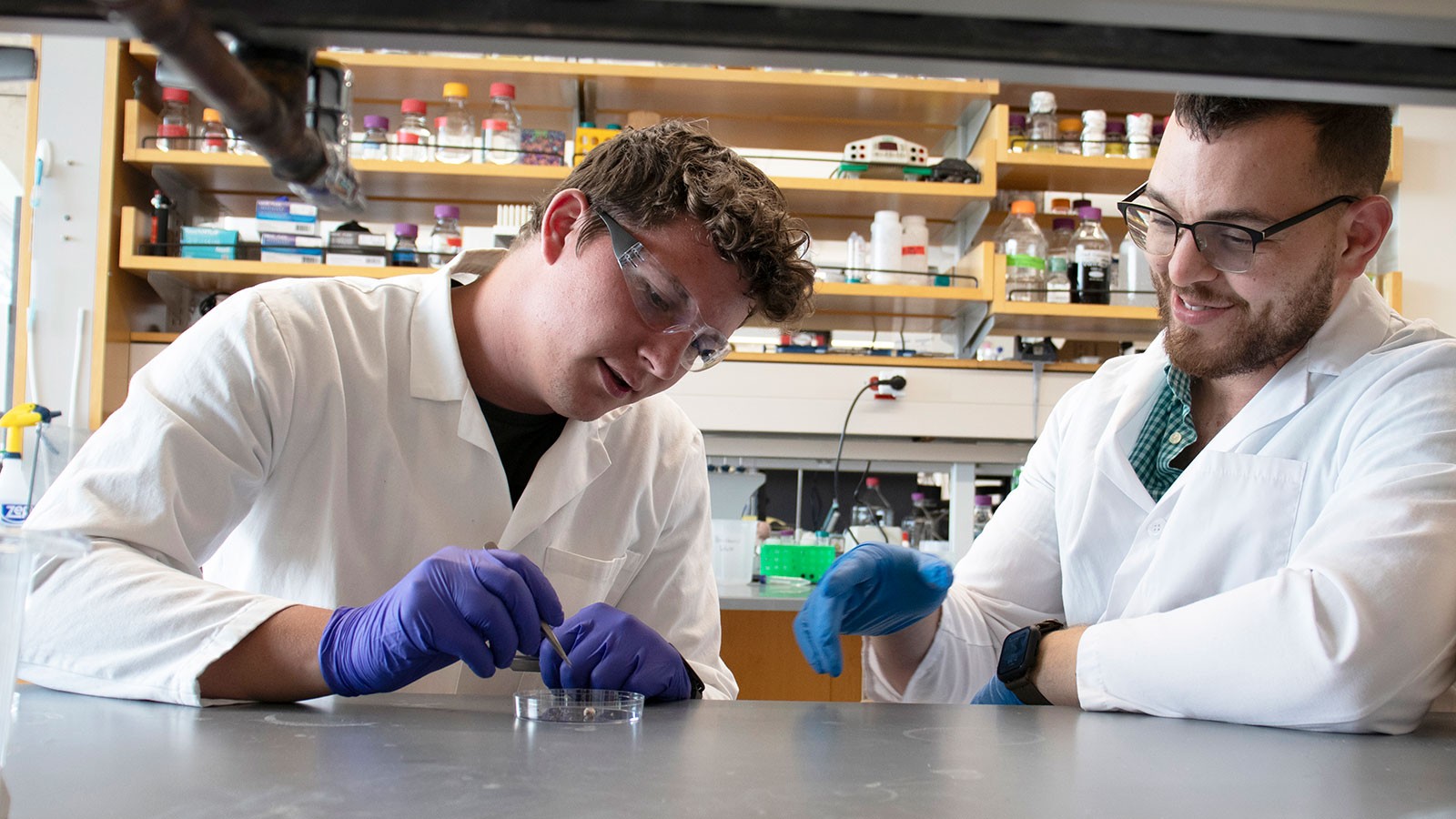Beyond Spiders & Abuzz With Possibilities: USU Researchers Explore Nature's Ancient Biomaterials
In Biologist Justin Jones' Lab, students Jackson Morley, Oran Wasserman and Mary-Kate Williams study bee silk.
By Mary-Ann Muffoletto |
Video by Taylor Emerson, Digital Journalist, University Marketing & Communications
For more than a decade, Utah State University scholars have pioneered research on the production and structure of synthetic spider silk. Building on lessons learned, researchers in the lab of biology faculty member Justin Jones are branching into organisms beyond the eight-legged arachnids to explore a broader range of organisms as potential candidates for production of replicable, recombinant fibers.
“Spider silks have exceptional mechanical properties, including high tensile strength, elasticity and biocompatibility, which make them attractive for biomaterials research and potential applications,” says Jones, assistant professor in USU’s Department of Biology. “However, manufacturing commercial-scale quantities of synthetic spider silk remains a challenge. So we’re exploring a range of creatures that produce fibers with equal or superior qualities.”
Among these organisms are the eel-like hagfish, which emits a gooey, fibrous slime when threatened by predators. Another marine animal that’s captured the lab’s interest is the transparent ctenophore, known colloquially as the comb jelly, which secretes a fibrous sticky substance to help reel in prey.
In addition to these rather exotic creatures, undergrad researcher Jackson Morley and doctoral student researcher Oran Wasserman, both Jones Lab members, are exploring an organism more familiar to Utahns: the bee.
“Oran heard, from fellow biology doctoral student Mary-Kate Williams, about a solitary bee that produces silk and is heavily studied at the USDA-ARS Pollinating Insect Research Unit here at USU,” says Morley, a USU Honors student and Aggie First Scholar. “Together with Dr. Jones, we sat down and developed a few projects to study the natural silk and to potentially recombinantly express the proteins composing the silk.”
These solitary bees, known as blue orchard bees and by their scientific name Osmia lignaria, begin their lives as larvae encased in tough-fibered cocoons, he says. Rather than hives, the ingenious masons use mud to construct partitioned nests to hold and protect the cocoons in harsh conditions.
“That ability to survive in tough terrain clued us into the impressive strength of the cocoon fibers,” Morley says. “And we identified the four genes that make up the proteins from which those fibers are made.”
The researchers set to work measuring the molecular weight of the bee proteins and found they were about 10 times lighter than spider silk proteins and about half the size of the hagfish intermediate filament proteins.
“Molecular weight and amino acid composition have an important impact on the silk properties, as well as its recombinant production efficiency,” says Morley, an aspiring physician who completed a bachelor’s degree in biochemistry in fall 2023. “The smaller the house, the more houses you can build, in theory, with the same number of bricks. And why might you want to build more houses? Because you get more bang for your buck.”
Could the recombinant production of bee protein provide a high enough yield to make it viable for commercial production and use? That’s a question the Aggie scientists will continue to explore.
In the meantime, Morley says the research has been challenging.
“For a whole semester, I struggled to gather enough fiber from the bee cocoons to build a usable dataset for the mechanical properties of the native bee silk,” he says. “For a long time, nothing was working.”
But with encouragement from his mentors, Jones and Wasserman, Morley found the grit to push through.
“I’ve really grown from this experience and what I’ve learned will help me as I pursue medical studies,” he says. “Both Dr. Jones and Oran are exceptional mentors who gave me a lot of research freedom but also provided invaluable guidance.”
Beyond the lab, Morley volunteers with others in the community who are struggling in difficult situations. Several times a week, Morley works with Bear River Association of Governments to assist with counts of unhoused people who are spending nights on the street in makeshift shelters and in vehicles.
“It’s a more common problem in Cache Valley than many people realize,” he says. “Encountering people in these situations keeps me grounded and reminds me that we all go through ups and downs, and we all need support from others to persevere.”
USU undergrad researcher Jackson Morley, left, and doctoral student Oran Wasserman examine a blue orchard bee cocoon in the Biology lab of faculty mentor Justin Jones. The researchers are exploring biomaterials made from the solitary bee's silk proteins. (Photo Credit: USU/M. Muffoletto)
WRITER
Mary-Ann Muffoletto
Public Relations Specialist
College of Science
435-797-3517
maryann.muffoletto@usu.edu
CONTACT
Justin Jones
Assistant Professor
Department of Biology
435-797-9292
justin.a.jones@usu.edu
TOPICS
Research 878stories Biology 165stories Bees 27stories Biotechnology 25stories Spider Silk 19storiesComments and questions regarding this article may be directed to the contact person listed on this page.







